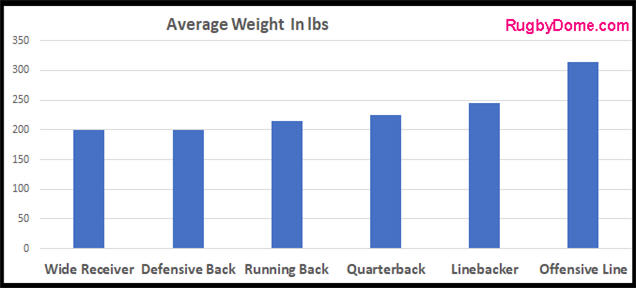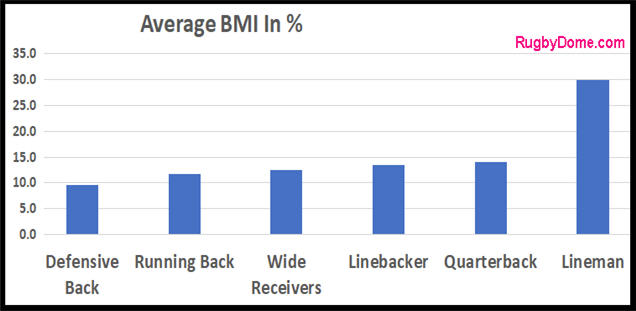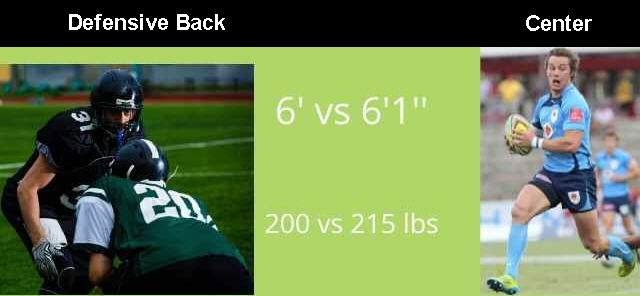The average weight of defensive backs in the NFL is 200 lbs in recent years. This is one of the lightest positions in football and is similar to the average wide receiver.
Defensive backs in college football have an average weight of 189 lbs.
Why Are Defensive Backs Lighter Than Many Other Positions?
Defensive backs average about 114 lbs lighter than offensive linemen, who are the heaviest players on the field.
That difference is the size of an adult Giant Octopus!
Defensive backs are also lighter than quarterbacks and linebackers. Here is how they stack up against other positions:

Why are defensive backs so light compared to many other positions? The reason is due to their role on the field.
One of their primary roles is to cover the wide receivers. So it’s no big surprise that the two positions share the same average weight.
Defensive backs rarely have to tackle, so they don’t need bulk. Instead, they need to be fast and agile enough to catch or intercept long passes.
With such an emphasis on speed and athleticism, defensive backs have to be relatively light.
Weights table across the NFL
| NFL | lbs |
| Offensive Line | 314 |
| Linebacker | 245 |
| Quarterback | 225 |
| Running Back | 214 |
| Wide Receiver | 200 |
| Defensive Back | 200 |
If you want more details about the other positions, check out these in-depth articles:
- Average weights of quarterbacks in NFL and college football
- Average weights of running backs in NFL and college football
- Average weights of linemen in NFL and college football
- Average weights of linebackers in NFL and college football
- Average weights of wide receivers in NFL and college football
How Do NFL Defensive Backs Compare To College Football?
College football players aren’t as heavy as professional NFL players, but they can still be pretty big.
The average weight of defensive backs in college football is 189 lbs, which is eleven pounds lighter when compared to the NFL.
That means college defensive backs don’t have to pile on as much weight as other positions in their rookie season in the NFL.
For example, Greg Ruegamer was a talented lineman at Arizona State who weighed 290 lbs in his senior year. The Miami Dolphins coach got on the phone to him on NFL draft day and asked him to add another 30 lbs to his bulk.
Defensive backs aren’t under the same kind of pressure when transitioning from college football.
How Do Defensive Backs Compare To The Average American Male?
The average American man weighs 196 lbs according to the CDC. That’s not much lighter than the average professional defensive back.
But what about body fat percentage?
A study in 2013 found that defensive backs have an average body fat percentage of 9.7%.
The average male in the United States has a percentage of about 28%, which makes defensive backs considerably leaner.
That may not surprise you. But how does this compare to the heaviest position in the NFL? Linemen clock in at nearly 30% body fat percentage.
Here is a comparison across NFL positions:

History Of Average Weights Of Defensive Backs In The NFL
It’s difficult to compare weights through history as positions and roles have changed significantly.
But we’ll take a look at some of the greats of past decades.
The famed Paul Krause weighed about 200 lbs when he started his career in the 1960s.
Jumping to the 1970s, Cliff Harris of the Dallas Cowyboys weighed about 188 lbs.
Willie Brown of the Oakland Raiders clocked in at 195 lbs in the 1980s.
Ty Law was about 200 lbs when he started his illustrious career in the mid 1990s.
It’s a small sample! However, it seems that defensive backs have stayed about the same weight through the past decades.
How Do Running Backs Compare To Other Sports?
Let’s take a look at heavyweights in boxing. Anthony Joshua weighs about 240 lbs, which is considerably heavier than the average running back.
But backs are 30 pounds heavier than the 170 lbs average weight of soccer players recorded at the 2018 World Cup.
But it doesn’t make a whole lot of sense to compare NFL with soccer players. We should look at another contact sport.
Rugby is probably the closest sport to American football.
Actually, didn’t one come from the other? No, not really. If you’re interested in football history, check out our article on whether American football evolved from rugby.
Running backs versus rugby centers
Of course, the positions and roles don’t line up easily when comparing the two games.
But we figure that centers in rugby are the closest position to defensive backs in football.
Centers in professional Rugby Union weigh an average of 215 lbs. That’s a significant two stone heavier than defensive backs.

Does height play a major factor in this weight difference? Not really. Centers are an inch taller on average than defensive backs.
So, the role is the difference. Defensive backs rarely make tackles, while tackling is one of the primary roles of centers in rugby. Hence the need for more bulk in the rugby position.